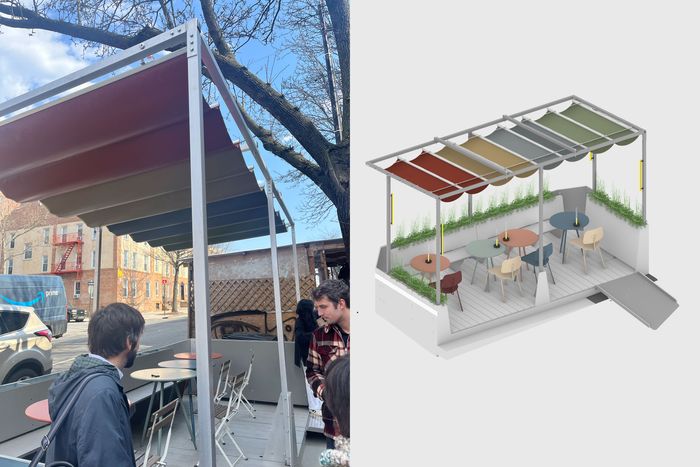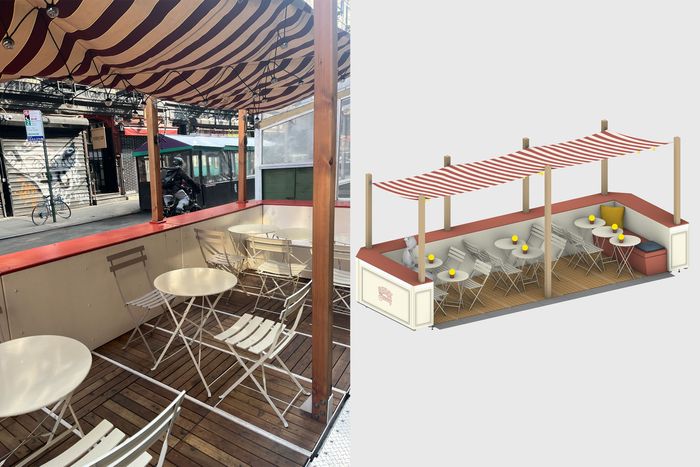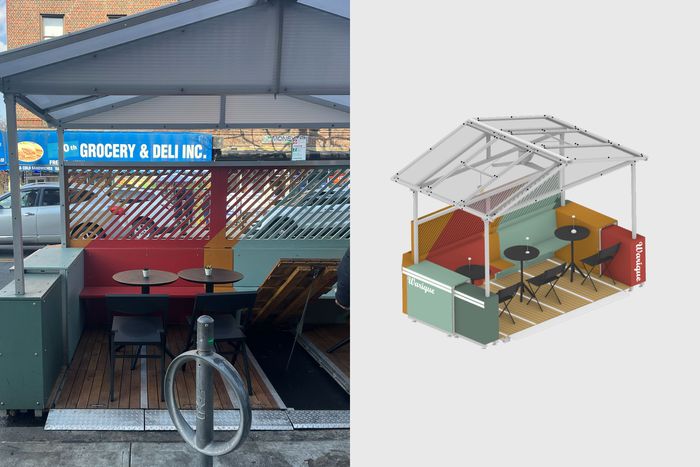The Future NYC Streetery Is a Kit of Parts


Photo-Illustration: Curbed; Photos: Ian Volner
“It’s definitely an improvement,” said Dawa Bhuti, smiling.
The Nepalese-born chef was standing outside her eponymous restaurant, Dawa’s, on Skillman Avenue, gesturing at a smart-looking metallic booth with built-in banquettes. For the past nine years, she and her father have been serving up a double menu here — part New American, part Himalayan — in their intimate storefront in Woodside; since 2020, they have also offered outdoor seating in a structure they built themselves. “That was in early April, when there was no inside dining,” Bhuti recalled. “We came up with our own. Very DIY.” They’ve built two successors since, each of which was a little more elaborate (and costly), but they weren’t that different from the first, or from countless others around the city: clunky human incubators made of plastic and wood, parked haphazardly on the street.
No longer. Together with three other restaurants in Manhattan and Queens, Dawa’s has been selected to pilot a Department of Transportation program aimed at revamping the city’s nearly 8,000 streeteries. This time around, the city is not leaving it to chance; it’s showing a few ways it can be done. “New Yorkers and tourists alike are addicted to alfresco dining,” said Ya-Ting Liu, the city’s chief public-realm officer, who appeared Tuesday morning alongside DOT commissioner Ydanis Rodriguez to unveil the new prototypes, set to roll out over the summer. “This new initiative reflects everything we’ve learned over the last four years.” Designed by WXY and fabricated by multidisciplinary studio SITU, the customizable modules, which can be assembled from a kit of standard parts, make it easier to follow the new guidelines and satisfy the demand to keep dining outdoors while tamping down on the idiosyncrasies of the first wave of sheds.
Dawa’s outdoor-dining structure and the Steep Street setup design by WXY that it’s based on.
Photo: Curbed; Photos: Ian Volner, Courtesy of NYC DOT
Those idiosyncrasies were not always without their charm. Yet the practical shortcomings of the first-generation sheds become obvious when looking at the four prototypes, each of which attempts to respond to some real-world challenge its predecessors were never quite up to — from the spacious and planter-lined Floating Parking-Lane Setup, installed at Bodrum, a Turkish restaurant on the Upper West Side, to the more compact yet ingenious Steep Street Setup in front of Dawa’s. Where the former has a bulk and formality that make it perfectly suited to its intended location, the latter, petite and topped by a hand-retractable canopy, is fitted with adjustable stilts concealed beneath the floor deck, allowing it to sit comfortably on Skillman’s sloping grade. Bhuti’s prior attempts to build a dining shed on a hill were far less successful; “I used to get complaints from DOT,” she said. Being drafted into the new program meant getting on steadier footing, literally and otherwise.
Then there is the question of how these stand up to traffic. “It was very important to daylight the corners,” said Claire Weisz, WXY’s founding principal. There are countless videos of the worst-case scenario: drivers making high-speed turns that smash sheds to splinters. The new models make such collisions far less likely; one of the types, the Corner Setup, is bolstered by a thick aluminum wall (its thick cavity doubles as storage space) that’s beveled at the corners, reducing how much it protrudes into the street and making it easier for drivers to see pedestrians and other drivers arriving at the intersection.
Photo: Curbed; Photos: Ian Volner, Courtesy of NYC DOT
On Orchard Street, the Corner Setup is getting its trial run in front of Sunday to Sunday, a vegetarian diner, where owner Gurpreet Singh seemed pleased with the results. “These outdoor things previously didn’t have any rhyme or reason to them,” Singh said. “They were just sort of plopped down.”
The move toward these standardized structures has the added advantages of being easy to source, assemble, and dismantle. “They’re made from off-the-shelf materials,” said WXY associate principal Jacob Dugopolski, referring to the marine plywood, steel tubing, and polycarbonate panels that make up most of the structural elements and finishes; bending down to the floor of the Corner Setup, Dugopolski showed off the slatted wooden panels that line the bottom, which are easy to take off and replace with store-bought parts. The structures are also simple to store, a major consideration now that the rules governing outdoor-dining sheds allow them to remain in place only between April to late November. Thanks to those seasonal limitations, the new prototypes did not have to accommodate as many heat lamps or be designed to be windproof or weatherproof. “They’re all open on the sides,” said Dugopolski, though he added that the new types could easily be retrofitted if the winter crowds keep coming.
Photo: Curbed; Photos: Ian Volner, Courtesy of NYC DOT
“I think it’s going to bring more customers,” said Jimmy Lozano, who owns Warique, a Peruvian restaurant in Jackson Heights. He pointed to the flexible design parameters that allowed him to give his Mid Block Setup the same colorful, Peruvian-inspired livery as his interior dining room. Better still, he said, “It’s clean” — like its other three counterparts, Lozano’s structure steps back from the gutter to ensure stormwater flow, and the metal plates that cover the gap can be lifted to sweep out garbage and food, thus combating the “rat condo” problem. While the DOT wouldn’t cite an exact figure for how much each one cost, it estimated each was in the tens of thousands and roughly comparable to most of the plywood structures that had been built already. At least it’s ready to go, which is one of its biggest advantages.
By November, most of the existing dining sheds will have to come down and be replaced by structures like these. Owners (as well as professional setup companies expected to rent out the stalls to restaurants) can start applying for one themselves around March 5 via an online portal, where they’ll also get help customizing the design; they can then find a contractor via a planned DOT marketplace and pay for the fees and buildout. By fall, if all goes according to plan, the last of the old sheds will come down, fully replaced by the prim newcomers. The post-pandemic streetscape may lose a little of its wooly, raffish appeal in the process — but at least there will be lower odds of having a rat as a dining companion.
Source link







